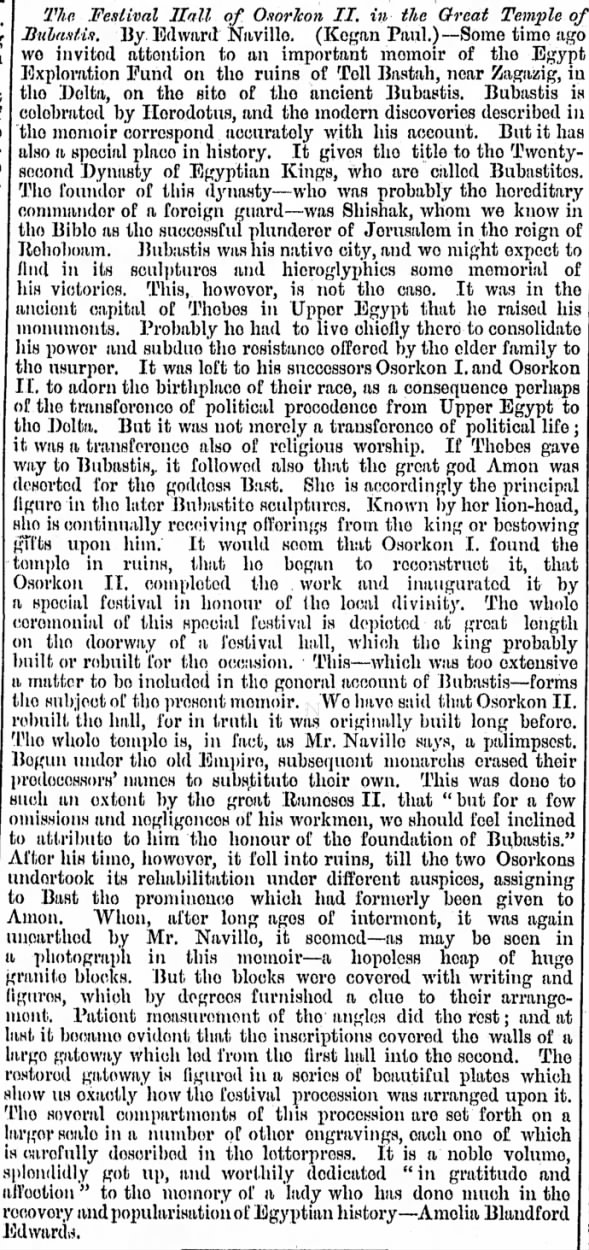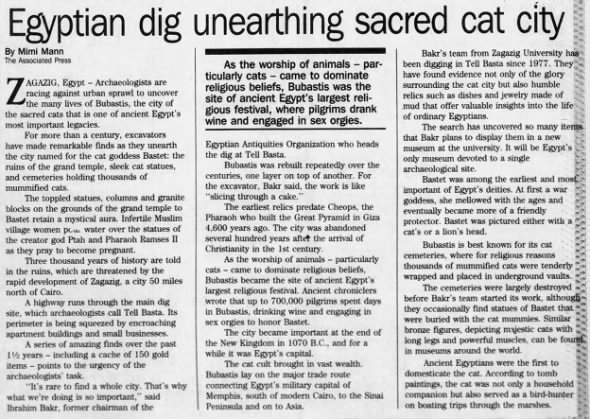|
Other Archaeological Sites / The Neolithic of the Levant (500 Page Book Online) Ancient Bubastis ( Zagazig) in the Egyptian Nile Delta Updated December 6th 2019 Bubastis (Bohairic Coptic: Ⲡⲟⲩⲃⲁⲥϯ Poubasti; Greek: Βούβαστις Boubastis[1] or Βούβαστος Boubastos[2]) -- also known in Arabic as Tell-Basta or in Egyptian as Per-Bast, was an Ancient Egyptian city. Bubastis is often identified with the biblical Pi-Beseth (Hebrew: פי-בסת py-bst, Ezekiel 30:17).[3] It was the capital of its own nome located along the River Nile in the Delta region of Lower Egypt and notable as a center of worship for the feline goddess Bastet. Its ruins are located in the suburbs of the modern city of Zagazig [WikiPedia] Bubastis (1887-1889) by Edouard Naville (1891) https://ancientneareast.tripod.com/PDF/bubastis1887188900navi.pdf TELL BASTA --- The most ancient mention of Bubastis which we meet with, apart from the Egyptian texts, exists in the prophet Ezekiel in the prophesy against Egypt. "The young men of Aven and of Pi-Beseth shall fall by the sword; and these cities shall go into captivity". The Septuagint, translating the passage, give the Greek names of the two cities; Aven is Heliopolis and Pi-Beseth is Bubastis; and they are followed by the Vulgate and the Coptic version. It is to Herodotus that we are indebted for the most complete description of Bubastis. The Greek writer speaks twice of the city; first in reference to the great festival which was celebrated there annually and afterwards when he gives a detailed description of the temple, to which we shall have to revert further. He also states that near Bubastis was the place where the canal to the Red Sea branched off from the Nile. From his account we learn that Bubastis was a large city of Lower Egypt and his statement is borne out by the narrative of the capture of the town by the generals of Artaxerxes, Mentor and Bagoas, which is found in Diodorus ... At Bubastis occurred for the first time what was to be the cause of the fall of several cities and especially of the capital; internal warfare between the foreign mercenaries and the Egyptian troops, each party betraying the other to the Persian general. Strabo speaks of the nome or province of Bubastis as being near the head of the Delta in the immediate vicinity of the nome of Heliopolis. Bubastis is one of the eight famous cities mentioned by Pomponius Mela among the twenty thousand said to have existed under Amasis, and of which many were still inhabited in his time. Roman coins of the time of Hadrianus bear the name of the nome of Bubastis. It occurs in Ptolemaeus and Stephanus Byzantinus. Hierocles quotes Bubastis among the cities of the second Augustamnica and it was one of the bishoprics of Egypt. A Byzantine chronographer John, Bishop of Nikiou, quotes the city of Basta in connection with a rebellion which took place under the Emperor Phocas, and the Arab geographer Macrizy speaks of it repeatedly. Among the provinces of Egypt was the district of Bastah, which contained thirty-nine hamlets. Bastah was given as allotment to the Arab tribes who had taken part in the conquest. Afterwards it belonged to the province of Kalioub. We do not know when it was abandoned. Travellers did not direct their attention to the place and the first to have noticed the ruins seems to be the Frenchman Malus, who took part in the Egyptian campaign at the end of last century. He gives the following description of the place :— "The ruins of Tell Bastah are seen from a great distance. They are seven leagues distant from the Nile and half a league from the canal (the Muizz) on its right side. We saw there several remains of monuments which may be useful for the history of Egyptian architecture. We noticed in particular part of a cornice of a very vigorous style ; the sculpture of it is fairly preserved. This block, which may be eight feet long and six high, is of a very hard red granite; the work is most elaborate, it is covered with hieroglyphs of which we made a drawing ......
A Handbook for Travellers in Egypt: including descriptions of the course of the Nile through Egypt and Nubia, Alexandria, Cairo, the pyramids and Thebes, the Suez Canal, the Peninsula of Mount Sinai, the Oases, the Fayum &c --- Fourth Edition -- John Murray Publisher (1873) https://ancientneareast.tripod.com/PDF/A_Handbook_for_Travellers_in_Egypt.pdf
The Festival Hall of Osorkon II in the Great Temple of Bubastis by Edward Naville (176 Pages) https://ancientneareast.tripod.com/PDF/festivalhallofos10navi.pdf
2019 Newspapers.com Article using search term Bubastis
2019 Newspapers.com Article using search term Bubastis
Bubastis --- WikiPedia
|





